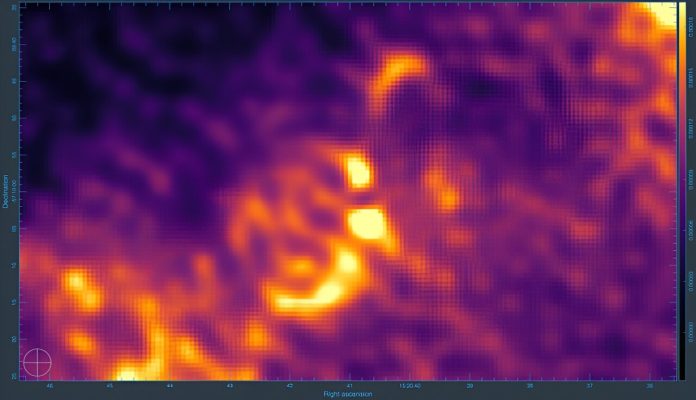
Astronomers have captured the first-ever image of a jet shooting out from a neutron star, resembling a garden sprinkler.
This fascinating discovery was made by a team of astronomers at the University of Oxford using the MeerKAT radio telescope in South Africa.
The neutron star in question is part of the Circinus X-1 binary system, located over 30,000 light-years from Earth.
Circinus X-1 is a binary system, meaning it consists of two stars bound together by gravity.
One of these stars is a neutron star, formed from the core of a massive supergiant star that collapsed around the same time Stonehenge was built. Neutron stars are incredibly dense; a teaspoon of their material would weigh as much as Mount Everest.
Unlike black holes, which are more massive and can only be detected through their gravitational effects, neutron stars can be directly observed despite their density.
The S-shaped jet was spotted emanating from the neutron star, a phenomenon never seen before with neutron stars but observed with black holes. This jet changes direction due to the wobbling of the disk of hot gas around the star, a process known as precession. The jet’s discovery was made possible by the high-resolution images from the MeerKAT telescope, which provided the most detailed look at Circinus X-1 to date.
Lead researcher Fraser Cowie explained that there is another system known for its S-shaped jets, called SS433, but recent evidence suggests it is likely a black hole. The symmetric S shape of the radio-emitting plasma in Circinus X-1’s jets and the fast, wide shockwave observed can only be produced by a jet changing direction. This discovery offers valuable insights into the extreme physics behind jet launching, a phenomenon still not well understood.
The jet’s power comes from a process called accretion, where the neutron star’s immense gravity strips gas from its companion star, forming a disk of hot gas spiraling down towards its surface. This process releases enormous amounts of energy, powering the jets that travel close to the speed of light.
Recent upgrades to the MeerKAT telescope have improved its sensitivity and resolution, allowing researchers to see the S-shaped structure in Circinus X-1’s jet. Additionally, the team discovered moving termination shocks for the first time in an X-ray binary. These shockwaves occur where the jet violently collides with surrounding material, moving at about 10% of the speed of light, confirming they were caused by the fast-moving jet.
The shockwaves act as particle accelerators in space, producing high-energy cosmic rays. Measuring the velocity of these shockwaves helps astronomers understand the composition of the jet. The fact that the shockwaves span a wide angle aligns with the model suggesting the neutron star jet is precessing.
Circinus X-1 is one of the brightest objects in the X-ray sky and has been studied for over 50 years, yet it remains one of the most puzzling systems known. This new discovery sheds light on its behavior and offers new insights into its properties. The team plans to continue monitoring the jets to see if they change over time, allowing for more precise measurements and a better understanding of this mysterious object.
“This discovery is very rewarding, building on decades of work by others,” Cowie said. “We hope to continue learning more about this puzzling system and its jets.”
This groundbreaking discovery not only advances our understanding of neutron stars but also opens new avenues for studying extreme astrophysical phenomena.



